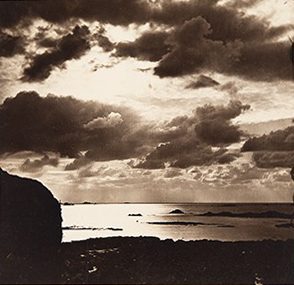
![]() In the photographs of the British photographer, Colonel Henry Stuart Wortley, no two skies are alike. While this fact might not seem particularly noteworthy today, in the early days of photography technical limitations often precluded capture of both the ground and sky in a single image. Photographers stockpiled separate negatives of skies to add to images of ground or water, sometimes using the same sky in different photographs.
In the photographs of the British photographer, Colonel Henry Stuart Wortley, no two skies are alike. While this fact might not seem particularly noteworthy today, in the early days of photography technical limitations often precluded capture of both the ground and sky in a single image. Photographers stockpiled separate negatives of skies to add to images of ground or water, sometimes using the same sky in different photographs.
Stuart Wortley, however, became adept at “instantaneous photography,” obtaining more light by shooting directly into the sun and taking advantage of additional light reflecting off the surface of water. He also experimented with chemical mixtures that enabled him to draw greater detail from relatively rapid exposures. By underexposing his plates, Stuart Wortley created high-contrast, dramatic views of the natural world that he often titled with lines from popular poems. He underexposed his negatives and used strong variations in contrast to achieve the effect of evening views, despite photographing at the brightest time of day.
Critics found much to praise in Stuart Wortley’s consciously artistic photographs. As a reviewer in The Photographic News wrote in the early 1860s, his “instantaneous pictures of sea, and cloud, and foreground, and atmospheric effect, are sublimely grand.”[footnote]Quoted in Katherine DiGiulio, National Variations: Photographs by Colonel Stuart Wortley (San Marino: The Huntington Library and Art Gallery, 1994), p. 8.[/footnote] Although some critics found fault with his daring underexposed photographs, which were seen as exaggerated and gloomy, they praised his mastery of what we might think of today as special effects. Indeed, in the nineteenth century, “effect,” or immediate emotional response, was a sought-after quality in art in general.

Compared to the documentary approach of many of Stuart Wortley’s American contemporaries, such as Carleton Watkins, Stuart Wortley’s photographs provide few details about landscape and topography. Instead they use dramatic cloud-filled skies to project a mood of sublime mystery.